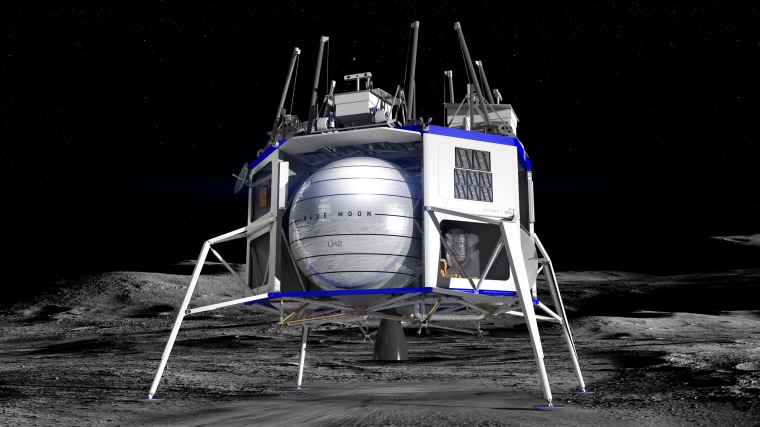Half a century after humans first set foot on the lunar surface, the world’s richest man has revealed a huge new lunar lander that he says will return humanity to the moon by 2024.
Jeff Bezos, chairman of Amazon and founder of the spaceflight company Blue Origin, unveiled the latter company’s Blue Moon lander on Thursday at a flashy press event in Washington.

The four-legged lander could carry two to four passengers and has an upper deck designed to hold different types of cargo. Its liquid hydrogen-powered rocket engine generates 10,000 pounds of thrust, according to the company. Fully loaded with fuel, it weighs about 33,000 pounds and has a payload capacity of up to 6.5 metric tons, or more than 14,000 pounds. That’s enough to carry four large lunar landers at once, Bezos said.
“This is an incredible vehicle, and it’s going to the moon,” he said.
The spidery-looking spacecraft resembles a bigger, boxier cousin of the iconic Apollo lunar modules that landed 12 NASA astronauts on the moon in the late 1960s and early 1970s. Its four landing pads, though, are noticeably smaller — something Bezos pointed out during the event.
“I was sure that those landing pads were too small,” he said. “And I asked about that, and the answer is these are not too small. The ones on the lunar Apollo lander are too big because we were very worried about how soft the lunar surface was.”
The lander will likely ride aboard Blue Origin’s New Glenn rocket, a 313-foot-tall booster that is still in development. It will be equipped with radio and laser-based communications gear, as well as a LiDAR system that uses laser beams to scan the lunar surface and guide the craft to its landing site.
In addition to landing humans and cargo on the moon, the lander will be able to deploy small moon-orbiting satellites during its descent to the lunar surface, according to Bezos.
Blue Origin hasn’t revealed any specific launch dates for Blue Moon, but Bezos said the hydrogen-powered BE-7 rocket motor would be test-fired for the first time this summer.
He said the Blue Moon lander is part of his broader vision of future generations living off Earth in orbiting space colonies.
He's not the only billionaire with lofty space ambitions. SpaceX CEO Elon Musk is designing an interplanetary vehicle known as Starship that he hopes will be used to one day colonize Mars. SpaceX is also planning to fly the first private passenger, a Japanese billionaire, on a mission around the moon in 2023.
Under direction from the Trump administration, NASA is aiming to return astronauts to the moon by 2024 and is developing a skyscraper-size rocket, known as the Space Launch System, to fly beyond Earth's orbit. An uncrewed test flight of the rocket is tentatively scheduled for 2020, but the booster's development is already three years delayed and has been plagued by budget issues.
Want more stories about space?
- First-ever photo of a black hole reveals what had been unseeable
- Self-driving spacecraft may help save Earth from deadly asteroid strikes
- NASA's $17 billion moon rocket may be doomed before it ever gets to the launch pad
SIGN UP FOR THE MACH NEWSLETTER AND FOLLOW NBC NEWS MACH ON TWITTER, FACEBOOK, AND INSTAGRAM.

